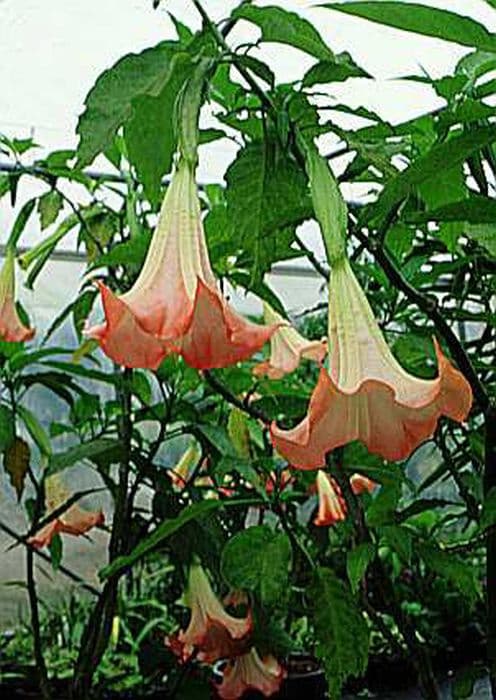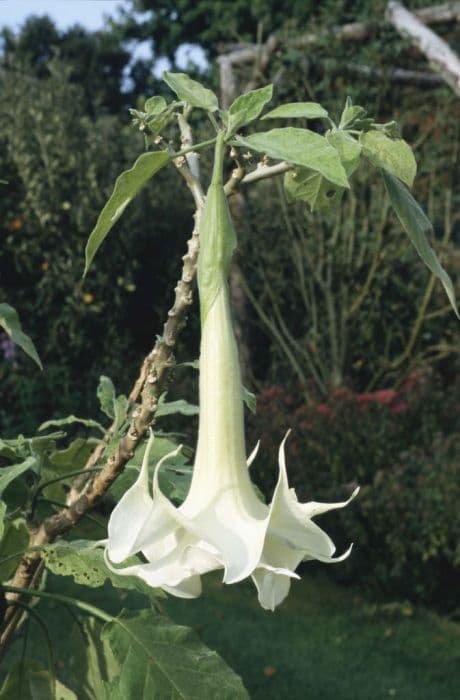Petunia Petunia Conchita Strawberry Frost = 'Constraw' (PBR) (Conchita Series)
![petunia [Conchita Strawberry Frost]](/_next/image?url=https%3A%2F%2Fplants-admin.emdemapps.com%2Fimages%2Fplants%2F%2Fimages%2F604b5d22564a1.png&w=3840&q=75)
ABOUT
The Petunia Conchita Strawberry Frost, part of the Conchita Series, flaunts a stunning display of flowers that present a delicate interplay of colors. Its blooms are characterized by a lush strawberry pink hue that gradually fades into a frothy white edging, reminiscent of a light dusting of frost. This subtle gradation creates a soft, romantic appearance, invoking the image of a strawberry dipped in cream. The flowers themselves are funnel-shaped, typical of the petunia family, showcasing a generous spread of petals that provide a continuous floral show. The plant has a robust and bushy form, which is covered in dark green foliage. The leaves are somewhat oval, with points at the tips and are of a size that nicely complements the flowers. Together, foliage and flowers create a full, mounded appearance that is rich in texture and color contrast, making this plant a visually captivating choice for gardeners seeking to add a touch of whimsical charm to their flower beds, hanging baskets, or containers. The allure of the Petunia Conchita Strawberry Frost is enhanced by its tendency to bloom profusely throughout the growing season, offering an abundant display that can enliven any garden space.
About this plant
 Names
NamesFamily
Solanaceae.
Synonyms
Petunia 'Constraw', Strawberry Frost Petunia.
Common names
Petunia 'Constraw'
 Toxicity
ToxicityTo humans
Petunias, including the variety known as 'Conchita Strawberry Frost', are generally not considered toxic to humans. They are not known to contain any toxic principles that would cause harm when touched or ingested. However, ingesting any non-food plant can potentially cause mild stomach upset due to the unusual nature of the material being consumed. If large amounts were consumed, one might experience nausea, vomiting, or diarrhea simply because the human digestive system is not adapted to processing large quantities of this plant material. Always exercise caution and avoid eating ornamental plants.
To pets
Petunias, like the 'Conchita Strawberry Frost', are generally regarded as safe for pets, and they are not listed as toxic to dogs or cats. If a pet were to ingest petunias, it is unlikely to result in poisoning. However, as with humans, ingestion of plant material that is not part of a pet’s normal diet can cause gastrointestinal upset, resulting in symptoms like vomiting or diarrhea. Therefore, it's still a good practice to prevent pets from consuming large amounts of any non-food plants, including petunias, to avoid potential digestive issues.
 Characteristics
CharacteristicsLife cycle
Annuals
Foliage type
Evergreen
Color of leaves
Green
Flower color
Pink
Height
10 inches (25 cm)
Spread
12 inches (30 cm)
Plant type
Herb
Hardiness zones
9
Native area
South America
Benefits
 General Benefits
General Benefits- Attractive Blooms: Petunia Conchita Strawberry Frost produces showy pink and white flowers that add a splash of color to garden spaces and attract pollinators such as bees and butterflies.
- Long Flowering Season: This variety of petunia offers a long flowering season, often blooming from spring until the first frosts of fall, providing continuous color in the garden.
- Versatile Planting Options: The petunia is suitable for various planting locations, including borders, beds, hanging baskets, and containers, offering flexibility in garden design.
- Low Maintenance: Petunias, including the Conchita Strawberry Frost, are relatively easy to care for and do not require extensive maintenance, making them a good choice for novice gardeners.
- Drought Tolerance: Once established, petunias can tolerate periods of drought, although they perform best when kept moist during long dry spells.
- Growth Habit: The Conchita Strawberry Frost has a mounding and spreading growth habit, making it effective as ground cover and in providing fullness to mixed plantings.
- Deer Resistance: Petunias are generally not preferred by deer, which makes them a suitable choice for gardens in areas where deer are a common problem.
 Medical Properties
Medical PropertiesThis plant is not used for medical purposes.
 Air-purifying Qualities
Air-purifying QualitiesThis plant is not specifically known for air purifying qualities.
 Other Uses
Other Uses- Companion planting: Petunias, such as the Strawberry Frost, can be planted alongside vegetables like tomatoes and peppers to help repel pests such as aphids and tomato hornworms.
- Natural dye: The vibrant colors of Petunia petals can be used to create natural dyes for fabrics or art projects.
- Educational tool: Petunias can be used in educational settings to teach children about plant biology, life cycles, and the importance of pollinators like bees and butterflies.
- Photography: Petunias are often used as subjects in photography due to their bright colors and variety, helping photographers learn about macro and nature photography.
- Artistic inspiration: Artists may use Petunias as a muse for paintings, drawings, and even sculptures, capturing the flower's form and color.
- Confetti: Once dried, Petunia petals can serve as biodegradable confetti for outdoor celebrations, reducing environmental impact.
- Holiday decorations: Petunias can be grown in festive colors and used in live floral arrangements for holidays and seasonal decorations.
- Culinary decoration: Edible Petunia flowers can be used as a colorful garnish on salads and desserts for an added visual appeal.
- Ice cubes: Petunia petals can be frozen inside ice cubes to create visually stunning additions to summer beverages.
- Theme gardens: Petunia Strawberry Frost can be included in themed gardens, such as a strawberry or ice-cream themed garden, because of its suggestive name and coloration.
Interesting Facts
 Feng Shui
Feng ShuiThe Petunia is not used in Feng Shui practice.
 Zodiac Sign Compitability
Zodiac Sign CompitabilityThe Petunia is not used in astrology practice.
 Plant Symbolism
Plant Symbolism- Resentment and Anger: Petunias are sometimes associated with feelings of resentment or anger due to their slightly aggressive nature in taking over spaces in gardens.
- Soothing Sensations: The soft color of 'Constraw' provides a sense of calm and can symbolize the need for tranquility in one's life.
- Desire: The petunia's vibrant blossoms are associated with a strong desire or your presence being soothing to someone.
- Comfort: The lush growth habit of the petunia can represent comfort and the presence of a nurturing environment.
 Water
WaterPetunias, including the Conchita Strawberry Frost, prefer even moisture and should be watered thoroughly once the top inch of soil feels dry to the touch. Generally, this might mean watering once every few days during hot, dry periods and less frequently during cooler, rainy spells. When watering, aim to apply water directly to the soil to avoid wetting the foliage, which can encourage disease. A good rule of thumb is to provide the plant with approximately 1 gallon of water per week, adjusting based on weather conditions and soil drainage.
 Light
LightPetunias like the Conchita Strawberry Frost thrive in full sun, which means they prefer at least six hours of direct sunlight per day. The best spot for these flowers would be in an unobstructed location where they can bask in the sun's rays for the majority of the day. If grown indoors, a south-facing window is typically ideal to provide the necessary light.
 Temperature
TemperaturePetunias, including the Conchita Strawberry Frost, perform best in temperatures ranging from 60 to 75 degrees Fahrenheit. They can tolerate lower temperatures down to about 40 degrees Fahrenheit, but frost can damage or kill the plant. Conversely, when temperatures soar above 85 degrees Fahrenheit, petunias may struggle and require additional attention to ensure they remain hydrated.
 Pruning
PruningPetunias, including Conchita Strawberry Frost, benefit from regular pruning to encourage bushier growth and more blooms. Deadheading, or removing spent flowers, should be done regularly to maintain a tidy appearance and promote continuous blooming. Light pruning to shape the plant can be done anytime, though significant cutbacks are best performed in late winter or early spring before new growth begins.
 Cleaning
CleaningAs needed
 Soil
SoilPetunias thrive in a well-draining, fertile soil mix enriched with organic matter like compost or peat moss, with a pH between 6.0 and 7.0 for optimal growth.
 Repotting
RepottingPetunias generally do not require frequent repotting and should be repotted only when they outgrow their current container, usually every 1-2 years.
 Humidity & Misting
Humidity & MistingPetunias prefer moderate humidity levels but are adaptable to typical outdoor conditions; no special humidity adjustments are necessary.
 Suitable locations
Suitable locationsIndoor
Provide bright light, well-draining soil, and regular watering.
Outdoor
Plant in full sun, use well-draining soil, and water regularly.
Hardiness zone
9-11 USDA
 Life cycle
Life cycleThe life of Petunia 'Constraw' begins with seed germination, which occurs in warm, moist soil in spring after the threat of frost has passed. After germination, the seedling stage follows, where the plant develops a basic structure with leaves and roots, initiating photosynthesis. As the petunia grows, it enters the vegetative stage, where it rapidly increases in size and foliage, preparing for flowering. Following this, the plant reaches the flowering stage, producing its distinctive strawberry frost-colored blooms that attract pollinators and garden admirers alike. After pollination, the petunia may produce seeds in a capsule, completing its reproductive cycle. As an annual plant, Petunia 'Constraw' will then senesce, or die off, usually after the first hard frost in the fall, although in some climates it may persist as a perennial.
 Propogation
PropogationPropogation time
Spring-Early Summer
The Petunia Conchita Strawberry Frost, or simply referred to as petunia, is commonly propagated by seed or vegetative means, but the most popular method is through seed sowing. Seed propagation typically starts in late winter to early spring, allowing for seedlings to mature before being transferred outdoors after the threat of frost has passed. To propagate petunias from seed, one should scatter the fine seeds sparingly over the surface of a well-drained seed starting mix, and barely cover them with a fine dusting of soil or vermiculite. The seeds require light to germinate, so the covering should be very light. The soil must be kept moist, but not soggy, and maintained at a warm temperature, ideally between 70 to 75 degrees Fahrenheit (21 to 24 degrees Celsius), to facilitate germination which usually occurs within 7 to 14 days. After germination, seedlings require ample light to grow strong before they can be hardened off and moved to outdoor conditions.


![Calibrachoa [Aloha Classic Blue Sky]](/_next/image?url=https%3A%2F%2Fplants-admin.emdemapps.com%2Fimages%2Fplants%2F%2Fimages%2F604b636c3778b.png&w=640&q=75)
![Calibrachoa [Aloha Classic Gold]](/_next/image?url=https%3A%2F%2Fplants-admin.emdemapps.com%2Fimages%2Fplants%2F%2Fimages%2F604b6284c573e.png&w=640&q=75)
![Calibrachoa [Aloha Classic Tiki Soft Pink]](/_next/image?url=https%3A%2F%2Fplants-admin.emdemapps.com%2Fimages%2Fplants%2F%2Fimages%2F604b548e0a5ef.png&w=640&q=75)
![Calibrachoa [Cabaret Deep Yellow]](/_next/image?url=https%3A%2F%2Fplants-admin.emdemapps.com%2Fimages%2Fplants%2F%2Fimages%2F604b5f20ca3ef.png&w=640&q=75)
![Calibrachoa [Calibasket Radiant Orange]](/_next/image?url=https%3A%2F%2Fplants-admin.emdemapps.com%2Fimages%2Fplants%2F%2Fimages%2F604b536d43cb2.png&w=640&q=75)
![Calibrachoa [Caloha Classic Blue Velvet]](/_next/image?url=https%3A%2F%2Fplants-admin.emdemapps.com%2Fimages%2Fplants%2F%2Fimages%2F604b604884a75.png&w=640&q=75)
![Calibrachoa [Caloha Classic Honey White]](/_next/image?url=https%3A%2F%2Fplants-admin.emdemapps.com%2Fimages%2Fplants%2F%2Fimages%2F604b5f56e0beb.png&w=640&q=75)
![Calibrachoa [Caloha Classic Yellow Chocolate Ring]](/_next/image?url=https%3A%2F%2Fplants-admin.emdemapps.com%2Fimages%2Fplants%2F%2Fimages%2F604b538aede95.png&w=640&q=75)